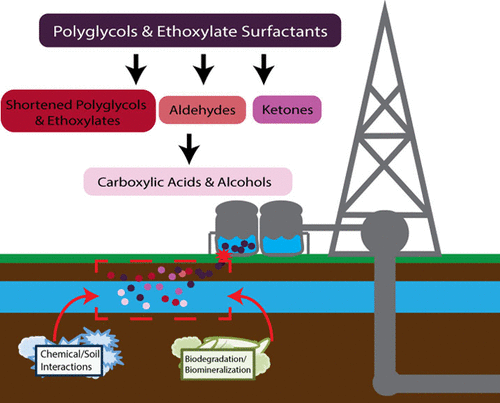当前位置:
X-MOL 学术
›
Environ. Sci. Technol.
›
论文详情
Our official English website, www.x-mol.net, welcomes your feedback! (Note: you will need to create a separate account there.)
Natural Attenuation of Nonionic Surfactants Used in Hydraulic Fracturing Fluids: Degradation Rates, Pathways, and Mechanisms
Environmental Science & Technology ( IF 11.4 ) Pub Date : 2017-11-13 00:00:00 , DOI: 10.1021/acs.est.7b01539 Katie M. Heyob 1 , Jens Blotevogel , Michael Brooker 1 , Morgan V. Evans 1 , John J. Lenhart 1 , Justin Wright 2 , Regina Lamendella 2 , Thomas Borch , Paula J. Mouser 1, 3
Environmental Science & Technology ( IF 11.4 ) Pub Date : 2017-11-13 00:00:00 , DOI: 10.1021/acs.est.7b01539 Katie M. Heyob 1 , Jens Blotevogel , Michael Brooker 1 , Morgan V. Evans 1 , John J. Lenhart 1 , Justin Wright 2 , Regina Lamendella 2 , Thomas Borch , Paula J. Mouser 1, 3
Affiliation

|
Hydraulic fracturing fluids are injected into shales to extend fracture networks that enhance oil and natural gas production from unconventional reservoirs. Here we evaluated the biodegradability of three widely used nonionic polyglycol ether surfactants (alkyl ethoxylates (AEOs), nonylphenol ethoxylates (NPEOs), and polypropylene glycols (PPGs)) that function as weatherizers, emulsifiers, wetting agents, and corrosion inhibitors in injected fluids. Under anaerobic conditions, we observed complete removal of AEOs and NPEOs from solution within 3 weeks regardless of whether surfactants were part of a chemical mixture or amended as individual additives. Microbial enzymatic chain shortening was responsible for a shift in ethoxymer molecular weight distributions and the accumulation of the metabolite acetate. PPGs bioattenuated the slowest, producing sizable concentrations of acetone, an isomer of propionaldehyde. Surfactant chain shortening was coupled to an increased abundance of the diol dehydratase gene cluster (pduCDE) in Firmicutes metagenomes predicted from the 16S rRNA gene. The pduCDE enzymes are responsible for cleaving ethoxylate chain units into aldehydes before their fermentation into alcohols and carboxylic acids. These data provide new mechanistic insight into the environmental fate of hydraulic fracturing surfactants after accidental release through chain shortening and biotransformation, emphasizing the importance of compound structure disclosure for predicting biodegradation products.
中文翻译:

水力压裂液中使用的非离子表面活性剂的自然衰减:降解速率,途径和机理
将水力压裂液注入页岩中,以扩展裂缝网络,从而提高非常规油藏的石油和天然气产量。在这里,我们评估了三种广泛使用的非离子型聚乙二醇醚表面活性剂(烷基乙氧基化物(AEOs),壬基酚乙氧基化物(NPEOs)和聚丙二醇(PPGs))的生物降解性,这些表面活性剂在注入的流体中起着耐候剂,乳化剂,湿润剂和缓蚀剂的作用。在厌氧条件下,无论表面活性剂是化学混合物的一部分还是作为单独的添加剂进行了修改,我们都观察到在3周内可以从溶液中完全去除AEO和NPEO。微生物酶促链缩短是乙氧基聚合物分子量分布变化和乙酸代谢产物积累的原因。PPG的生物衰减最慢,产生相当大浓度的丙酮(丙醛的异构体)。表面活性剂链的缩短与二醇脱水酶基因簇的丰度增加有关(从16S rRNA基因预测的Firmicutes基因组中的pduCDE)。的pduCDE酶负责乙氧基化物链单元的裂解成醛其发酵成醇和羧酸之前。这些数据为通过链缩短和生物转化意外释放后的水力压裂表面活性剂的环境命运提供了新的机械原理,强调了化合物结构公开对于预测生物降解产物的重要性。
更新日期:2017-11-14
中文翻译:

水力压裂液中使用的非离子表面活性剂的自然衰减:降解速率,途径和机理
将水力压裂液注入页岩中,以扩展裂缝网络,从而提高非常规油藏的石油和天然气产量。在这里,我们评估了三种广泛使用的非离子型聚乙二醇醚表面活性剂(烷基乙氧基化物(AEOs),壬基酚乙氧基化物(NPEOs)和聚丙二醇(PPGs))的生物降解性,这些表面活性剂在注入的流体中起着耐候剂,乳化剂,湿润剂和缓蚀剂的作用。在厌氧条件下,无论表面活性剂是化学混合物的一部分还是作为单独的添加剂进行了修改,我们都观察到在3周内可以从溶液中完全去除AEO和NPEO。微生物酶促链缩短是乙氧基聚合物分子量分布变化和乙酸代谢产物积累的原因。PPG的生物衰减最慢,产生相当大浓度的丙酮(丙醛的异构体)。表面活性剂链的缩短与二醇脱水酶基因簇的丰度增加有关(从16S rRNA基因预测的Firmicutes基因组中的pduCDE)。的pduCDE酶负责乙氧基化物链单元的裂解成醛其发酵成醇和羧酸之前。这些数据为通过链缩短和生物转化意外释放后的水力压裂表面活性剂的环境命运提供了新的机械原理,强调了化合物结构公开对于预测生物降解产物的重要性。



























 京公网安备 11010802027423号
京公网安备 11010802027423号